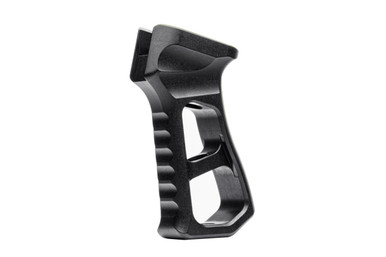The Valve To preface this one, I want to reiterate that the Ghost experience I've had is unique. The serial on this one ends in 0013, which I take to mean the 13th off the line. It was in my hands for testing 4 weeks prior to product launch. It came with components that were a surprise to AOA staff, and supposedly were not ever meant to have made it to the US market. In short, the Ghost that I was sent to review was not quite a prototype, but also not quite the production version.
With that preface....the third valve started leaking recently. And I think I finally know why I've had trouble with them.
To recap....
The valve that was installed by the factory started leaking in early December, if memory serves. AOA sent me a replacement valve and it held air until about a month ago, at which time AOA sent me a third valve. The third only held air for 2 weeks. AOA just recently sent me a 4th valve and it is in the gun now, holding air.
Valve 1 and 2 were identical in every way that I could measure.
Valve 3 and 4 are identical in every way, but different than 1 and 2.
My assumptions, based on valve inspections and experience with them is that 1 and 2 were not the more recently released "Ultra Valve," while 3 and 4 ARE the Ultra Valve.
And yes, the BRK Ghost, the Alpha Wolf, and the Delta Wolf all use the same valve (the most recent iteration being the "Ultra").
The three leaker valves all exhibited the same leak, air coming out of the barrel, a strong indicator that the poppet/valve stem is the culprit. I replaced orings, and even tried lapping the poppet to the face of the valve that it seals on and could not make any of the leaker valves hold air again. Valve 1 and 2 did not come with a buffer oring in the bottom of the valve stem pocket, on the opposite end of the valve stem from where the hammer strikes it.
What I'm calling the buffer oring is the little white loose oring in this photo. As near as I can tell, it is not a sealing oring, but a buffer to prevent the valve stem from impacting the steel blind hole/pocket. And yes, inclusion/omission has an effect on shot cycle/power output.
And the pocket it sits in.....
Valve 3 and 4 DID come with that buffer oring, but I removed it, with the thought process being that I wanted to match my known fps for each of the 3 power wheel settings that I've been using for each of the 3 .20 projectiles that I've been shooting. (I also shimmed the valve return spring b/c it improves the shot cycle but I don't think that was the cause of my problems). And configuring it like the previous valve DID mostly replicate what I was seeing from the previous valve. But valve #3 started leaking within 2 weeks, so something was wrong.
Upon receipt of the 4th valve I remembered that saying about repetition and expecting different results.....So I decided to install the valve as-received. I left that buffer oring in place and I did not shim the valve return spring. I figured a long chrony session to find new wheel settings was the lesser of the two evils over a 4th leaky valve. So into the gun it went, straight OEM. And the 4th valve is holding air after quite a few shots. Yes, shot cycle is different, and yes I needed to find new wheel settings to get to the desired 805-810fps with .20/13.73, 910-915fps with .20/15.89, and 875fps with .20/18.9 NSA slugs.
So what was the reason for the leaky valves? I'm not 100% positive but I'm thinking that buffer oring is the answer. AOA told me they had leaker valves back around the end of the 2022, but weren't seeing anymore in the the more recent guns. My first two leaker valves were from that time frame. Neither of those had that buffer oring. I think Daystate/BRK realized it was necessary b/c the 3rd valve had it. Of course I'm a dummy and removed the buffer oring from the 3rd valve prior to install and had the exact same issue as valve 1 and 2. I think that valves without that buffer oring allow the valve stem to be damaged. And I can't determine if the damage is from an imperceptibly bent valve stem, or from the composite poppet partially separating from the metal valve stem. Part of the reason that I've come to this conclusion is that the valves have a metallic ping when used at higher hammer spring settings and without the buffer oring. I think that ping was the valve stem slamming into that steel pocket, and eventually being damaged from it, over the course of thousands of shots. With the 4th valve installed (WITH buffer oring) and "max" on the hammer spring tension, the ping is absent.
I think (and I'm hoping) that the buffer oring prevents valve stem damage.
I'm really excited to have the Ghost back up and running!


